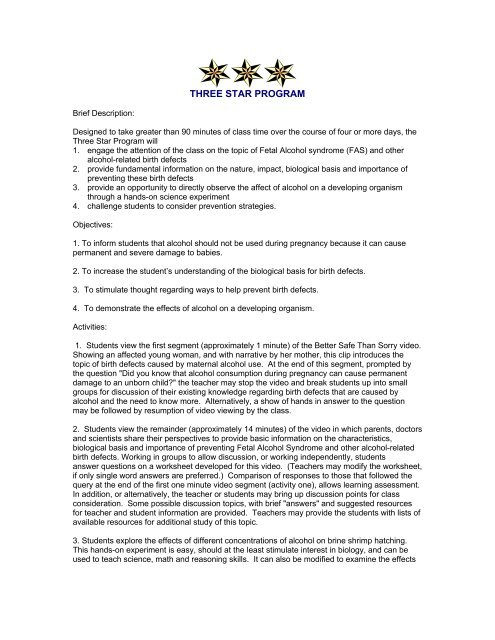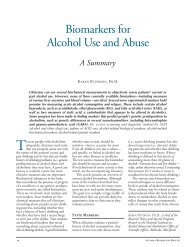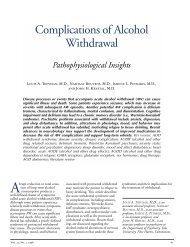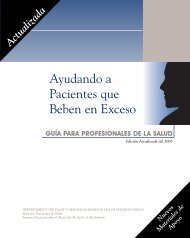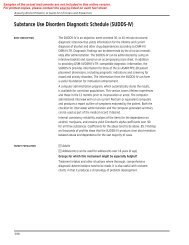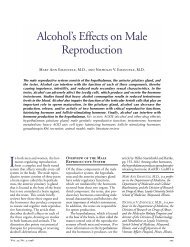Alcohol Syndrome (FAS) and Other Alcohol-Related Birth Defects
Alcohol Syndrome (FAS) and Other Alcohol-Related Birth Defects
Alcohol Syndrome (FAS) and Other Alcohol-Related Birth Defects
Create successful ePaper yourself
Turn your PDF publications into a flip-book with our unique Google optimized e-Paper software.
Brief Description:<br />
THREE STAR PROGRAM<br />
Designed to take greater than 90 minutes of class time over the course of four or more days, the<br />
Three Star Program will<br />
1. engage the attention of the class on the topic of Fetal <strong>Alcohol</strong> syndrome (<strong>FAS</strong>) <strong>and</strong> other<br />
alcohol-related birth defects<br />
2. provide fundamental information on the nature, impact, biological basis <strong>and</strong> importance of<br />
preventing these birth defects<br />
3. provide an opportunity to directly observe the affect of alcohol on a developing organism<br />
through a h<strong>and</strong>s-on science experiment<br />
4. challenge students to consider prevention strategies.<br />
Objectives:<br />
1. To inform students that alcohol should not be used during pregnancy because it can cause<br />
permanent <strong>and</strong> severe damage to babies.<br />
2. To increase the student’s underst<strong>and</strong>ing of the biological basis for birth defects.<br />
3. To stimulate thought regarding ways to help prevent birth defects.<br />
4. To demonstrate the effects of alcohol on a developing organism.<br />
Activities:<br />
1. Students view the first segment (approximately 1 minute) of the Better Safe Than Sorry video.<br />
Showing an affected young woman, <strong>and</strong> with narrative by her mother, this clip introduces the<br />
topic of birth defects caused by maternal alcohol use. At the end of this segment, prompted by<br />
the question "Did you know that alcohol consumption during pregnancy can cause permanent<br />
damage to an unborn child?" the teacher may stop the video <strong>and</strong> break students up into small<br />
groups for discussion of their existing knowledge regarding birth defects that are caused by<br />
alcohol <strong>and</strong> the need to know more. Alternatively, a show of h<strong>and</strong>s in answer to the question<br />
may be followed by resumption of video viewing by the class.<br />
2. Students view the remainder (approximately 14 minutes) of the video in which parents, doctors<br />
<strong>and</strong> scientists share their perspectives to provide basic information on the characteristics,<br />
biological basis <strong>and</strong> importance of preventing Fetal <strong>Alcohol</strong> <strong>Syndrome</strong> <strong>and</strong> other alcohol-related<br />
birth defects. Working in groups to allow discussion, or working independently, students<br />
answer questions on a worksheet developed for this video. (Teachers may modify the worksheet,<br />
if only single word answers are preferred.) Comparison of responses to those that followed the<br />
query at the end of the first one minute video segment (activity one), allows learning assessment.<br />
In addition, or alternatively, the teacher or students may bring up discussion points for class<br />
consideration. Some possible discussion topics, with brief "answers" <strong>and</strong> suggested resources<br />
for teacher <strong>and</strong> student information are provided. Teachers may provide the students with lists of<br />
available resources for additional study of this topic.<br />
3. Students explore the effects of different concentrations of alcohol on brine shrimp hatching.<br />
This h<strong>and</strong>s-on experiment is easy, should at the least stimulate interest in biology, <strong>and</strong> can be<br />
used to teach science, math <strong>and</strong> reasoning skills. It can also be modified to examine the effects


